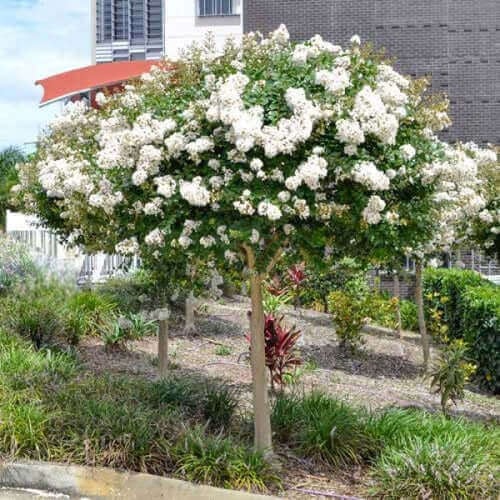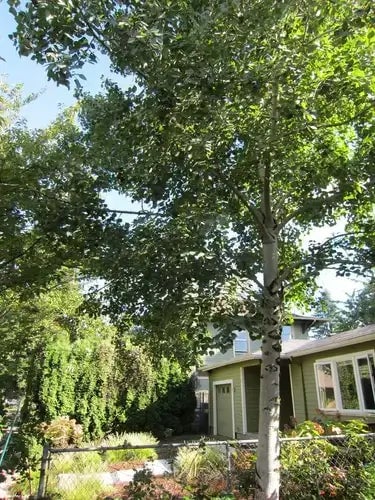Trees, like all living organisms, are subject to a host of Disease
Here, we explain the common causes and treatment of tree injury due to damage or disease. As a conscientious homeowner, you provide your trees and shrubs with all the necessities. However, insects and diseases may still cause issues. Fortunately, most healthy, mature trees and branchy bushes can defend themselves against minor threats from insects and other hostile forces.
In most cases, leaf-producing trees and shrubs can tolerate substantial foliar loss, caused by feeding insects or fungal diseases. Interestingly, a healthy and well-rooted plant can suffer total leaf loss one season and return with renewed vigor the next.
Most trees have latent buds that only sprout when necessary, meaning a few missing leaves will soon be replaced. Chances are, you’ll never know the difference. Leaves that sustain massive damage still conduct photosynthesis, meaning they always do their job, even if hungry inhabitants have snacked on them.
The Foliage Is The Most Bothered By Diseases
If a tree or shrub is subjected continuously to defoliation, it may become susceptible to disease or infestation. Severe fungal infection or insect invasion may require treatment.
Fortunately, disease and insects usually avoid healthy trees and shrubs. But even a hardy plant under stress can still have problems. Factors that can stress an otherwise healthy plant include poor pruning, drought, nutritionally deficient soil, and flood conditions.
Young trees are at the highest risk of damage from insects or disease. They buy trees from a reputable online nursery to ensure the healthiest stock.
Diagnosing problems
Many types of diseases present with similar symptoms. It is imperative to accurately assess a plant’s situation to efficiently identify the cause of concern. Often, a tree exhibiting outward issues suffers from more than one affliction, as secondary invaders are attracted to already-stressed leaves and emerging greenery. Problems to look for when diagnosing a tree’s condition include:
Incorrect soil conditions may include inappropriate moisture content or nutrient deficiencies.
Poor fertility
Climate extremes: Most climates change from season to season gradually, but they can wreak havoc on young plants when there is a sudden and significant shift. Climate issues are most common around late spring, when winter may arrive unexpectedly for a brief visit.
Environmental concerns: The air, water, and soil surrounding a tree or group of trees can change at any time. Underground water sources are subject to pollution from run-off chemicals, especially in spring and summer when pesticide usage on crops is at its peak.
Physical injuries: Trees subject to the municipal topping (to prevent downed wires) sustain significant visible damage. Other damage can occur in less obvious ways, including placing large trenches within the range of the tree’s root system.
CODIT: Compartmentalization of Decay in Trees occurs when a tree is wounded, usually by limbs being improperly removed. The tree releases sap and resins to “seal” the wound. The living tissue on the outside heals, while the inside may continue to decay.
Treatment For Plant Diseases Caused By Insects
Cavities and drainage tubes: Despite outdated beliefs, tree cavities do not require drainage tubes. Instead, allow the hole to remain open and control insect populations as necessary.
Wound dressing – Trees, including fruit-bearing varieties, can naturally treat most minor – and even significant wounds. Never attempt to dress a wound; exposure to open air is the best way to encourage new growth and wound closure.
Injections/implants: Tree-safe chemical agents can control many insects, nutrient deficiencies, and diseases. Injections of these chemicals should only be considered a last resort as they require careful drilling. Drill holes are open wounds for trees that, if improperly inflicted, can further damage the plant’s delicate base. It would be best to keep injection holes to a minimum; annual re-treatment is only recommended in extreme cases and for large, well-established trees.
Cabling/bracing – Severely damaged trees may be saved by the wiring or bracing of structural defects. That is not something that an untrained group of people should perform. You should consult a professional arborist familiar with the technique. Improper bracing will create an unsafe environment, primarily if the tree is located near a home or other area prone to human or animal occupation.
Damaged trees are considered a liability by most insurance companies. Accidents resulting from improper care or neglect may not be covered under your homeowner policy, leaving you to pay the bill for any property loss or human injury.
The best way to ensure lasting tree health is to buy from an online nursery that takes pride in preventing damage from seed to sapling.
How to Create a Pest-Resistant Garden for a Healthier, More Resilient Landscape
A balanced ecosystem that creates a healthy garden free from pests depends on multiple harmonious factors. Plants thrive better against insects and diseases when they grow in nutrient-rich soil populated with beneficial organisms. You can minimize pesticide usage while sustaining a flourishing garden by fostering robust plants alongside natural pest repellents and promoting diverse plant life.
First, start with high-quality soil. Well-draining, nutrient-rich soil is one of the most critical elements for successful gardening. It is beneficial to incorporate organic materials like compost or leaf mold to enhance soil structure. Healthy soil composition enables plants to access necessary nutrients and water more effectively. The practice leads to stronger root systems while improving plant resistance to pest attacks. Well-structured soil provides a habitat for beneficial microbes that break down organic material while keeping harmful pathogens at bay.
Plant types that can thrive in your climate conditions and possess natural resistance to local pests and diseases should be selected. When you choose seeds or seedlings that have adapted to your local region, you minimize plant stress to encourage vigorous growth, which enables plants to resist pest infestations.
Crop rotation is a practical method for preventing pest populations from establishing themselves in your fields. Specific plant families serve as targets for numerous insects and diseases. The annual practice of planting different crops in different locations disrupts pest life cycles and stops them from accumulating in the soil. You can combat cabbage worm infestations in your brassicas (kale, broccoli, or cabbage) by planting a different plant family in their location next season to break the pest cycle and minimize chemical use.
Encourage biodiversity through companion planting. Combining various plant species deters pests and draws in helpful insects, improving plant vitality. Marigolds act as a deterrent to specific nematodes, while basil repels flies. Ladybugs, lacewings, which eat aphids, and mealybugs are drawn to garden herbs such as dill and fennel. A garden with diverse plant varieties tends to experience fewer pest-related issues.
Maintain good garden hygiene. Keep your garden tidy and clean by removing dead leaves, spent blooms, and other debris from plants. Insects hide in plant debris while fungi establish breeding grounds on it. When diseased branches or leaves show up in your garden, they must be removed immediately and disposed of correctly. Proper maintenance reduces pathogens while preserving your garden's visual appeal.
Natural barriers enhance your garden's protection. Seedlings stay safe under lightweight row covers that keep birds and insects away, while netting prevents larger animals from reaching berries. Consistently monitor both airflow circulation and pollination needs. Lift the protective covers to enable pollinators to access plants during their flowering phase.
Integrated pest management relies on natural predators to control pest populations. The control of pest populations depends on the natural predation activities of birds, bats, frogs, and helpful insects. Birdhouses and birdbaths serve as practical tools to draw in birds, and shallow water features attract frogs because they prey on slugs. Nectar-rich flowers attract pollinators and predatory insects, which help manage pest populations and promote ecological balance.
Water wisely. Overhead watering produces wet conditions on plant leaves, leading to fungal infections and making them attractive to slugs. To prevent disease and pest problems, drip irrigation systems or water plants should be used at their base during early morning hours to ensure leaves dry before dusk. This practice reduces the likelihood of mold and mildew developing.
Finally, monitor your garden closely. The ability to detect pests quickly is vital for effective pest management. Check leaves and stems together with the soil routinely for any indications of damage or pest activity. Remove pests by hand whenever you can, but use chemicals only when necessary. Natural methods sustainably protect your garden while balancing surrounding wildlife and environmental conditions.
Plant spacing can improve pest resistance and garden health. When plants are crowded together, higher humidity levels and reduced airflow create conditions that allow harmful insects and diseases to prosper. Proper plant spacing minimizes pest problems while guaranteeing sufficient sunlight and water access, so plants become healthier with a more robust garden structure.
Using these techniques together develops a varied and strong ecosystem supporting plant growth while controlling pest populations. Healthy soil, careful plant selection, beneficial organisms, and regular responsible maintenance lead to a genuinely pest-resistant garden. Adopting these methods creates a long-lasting garden that nurtures plant health while benefiting the environment and enhances defense against pests and diseases for future seasons.
Read more

Natchez White Crepe MyrtleScientific Name: Lagerstroemia induce x fauriei "Natchez"Hardy Zones: 7-10Growth/Year: 3 to 5 feet per yearHeight: 20' to 30' highSpread: 15 to 25 feetSoil Requirements: D...

The most straightforward explanation of a carbon footprint is this: the total amount of carbon dioxide a person (company, family, state, etc.) disperses into the atmosphere as a direct or indirect ...


